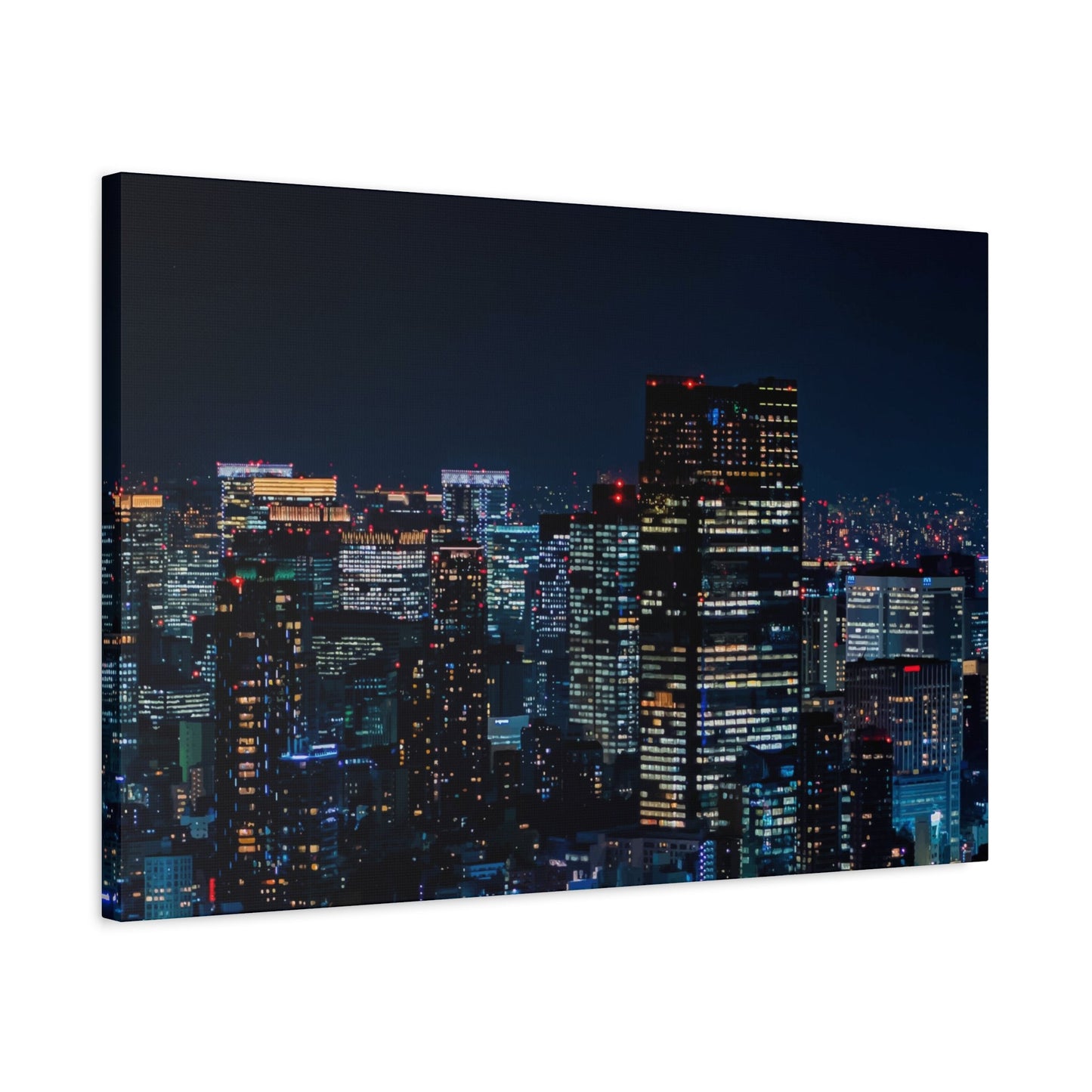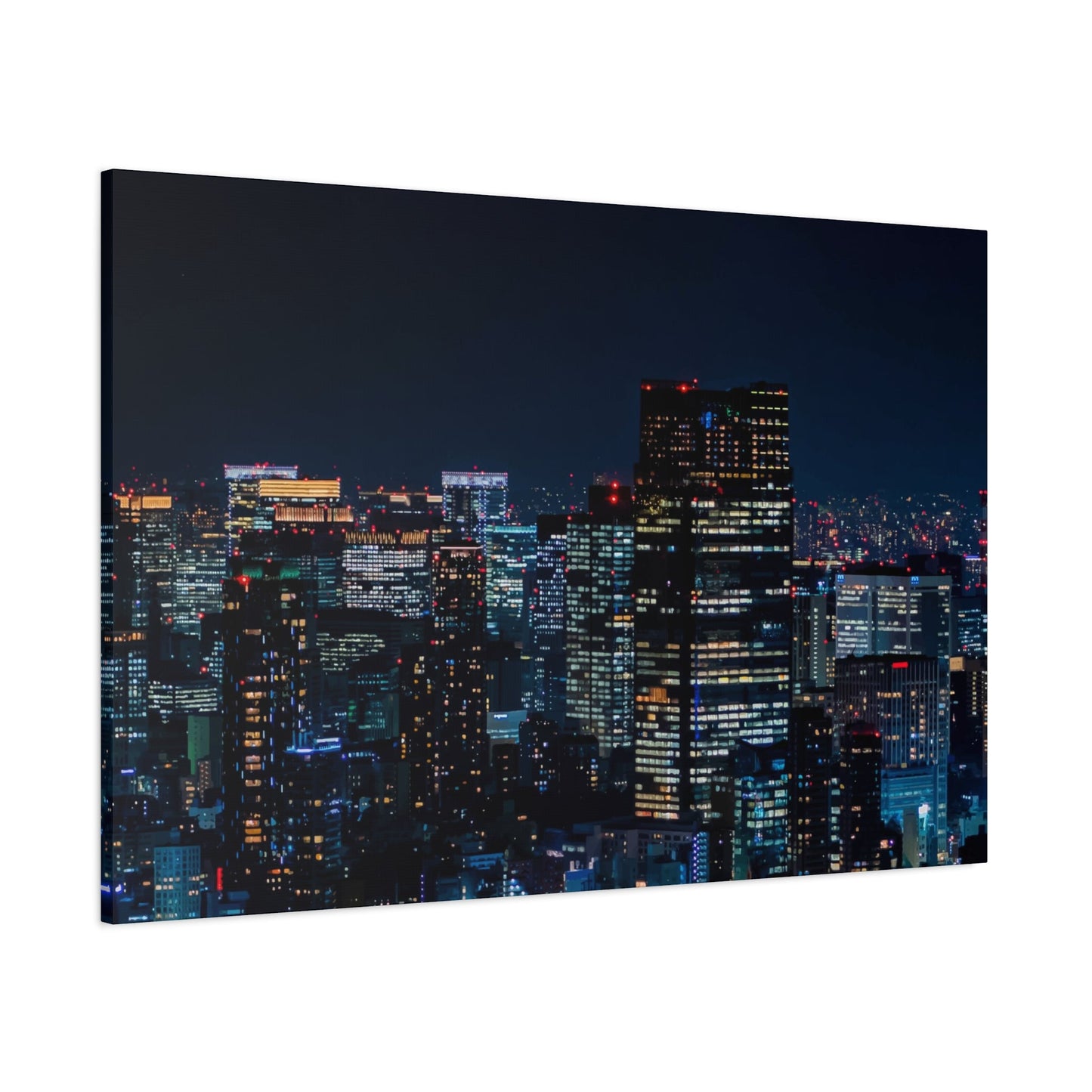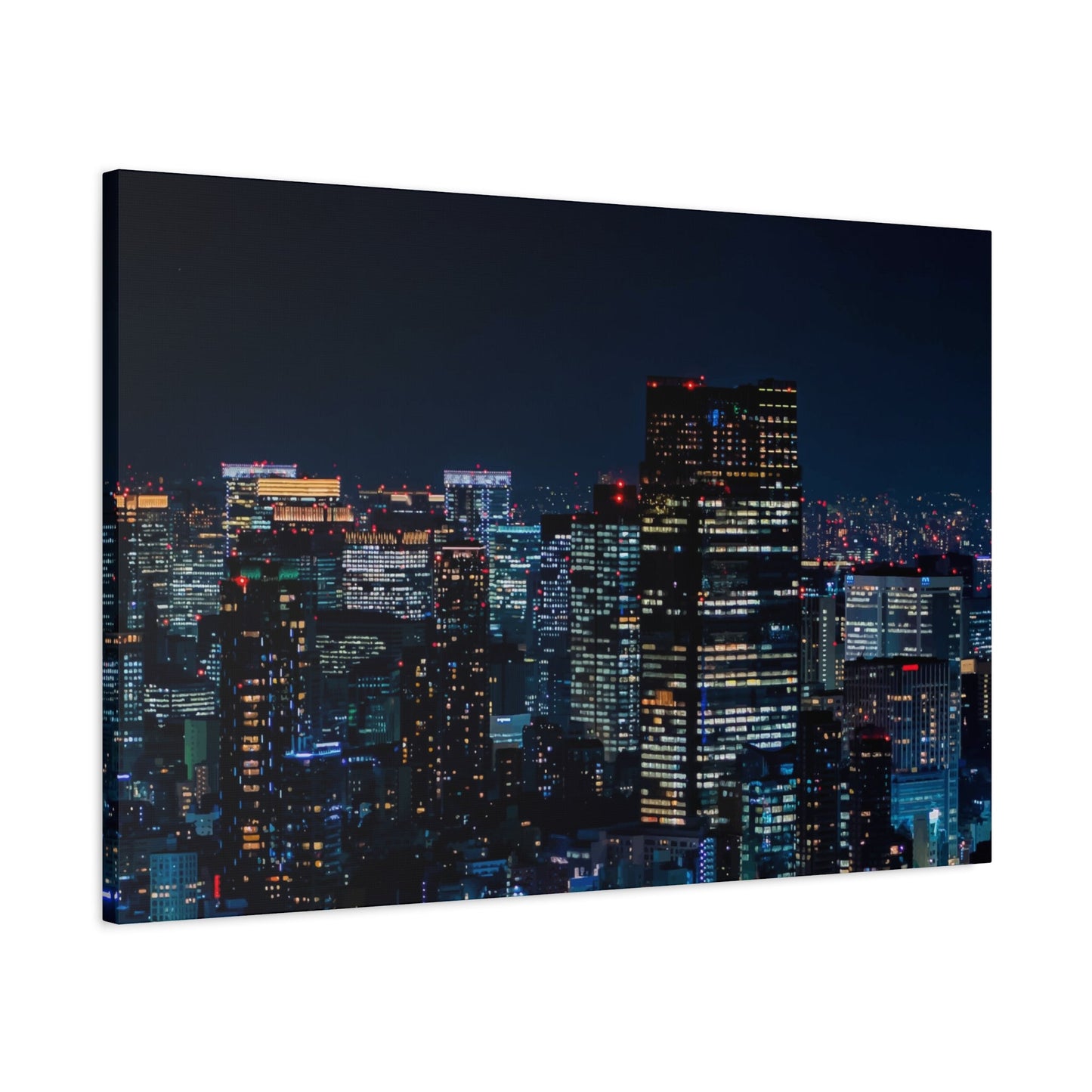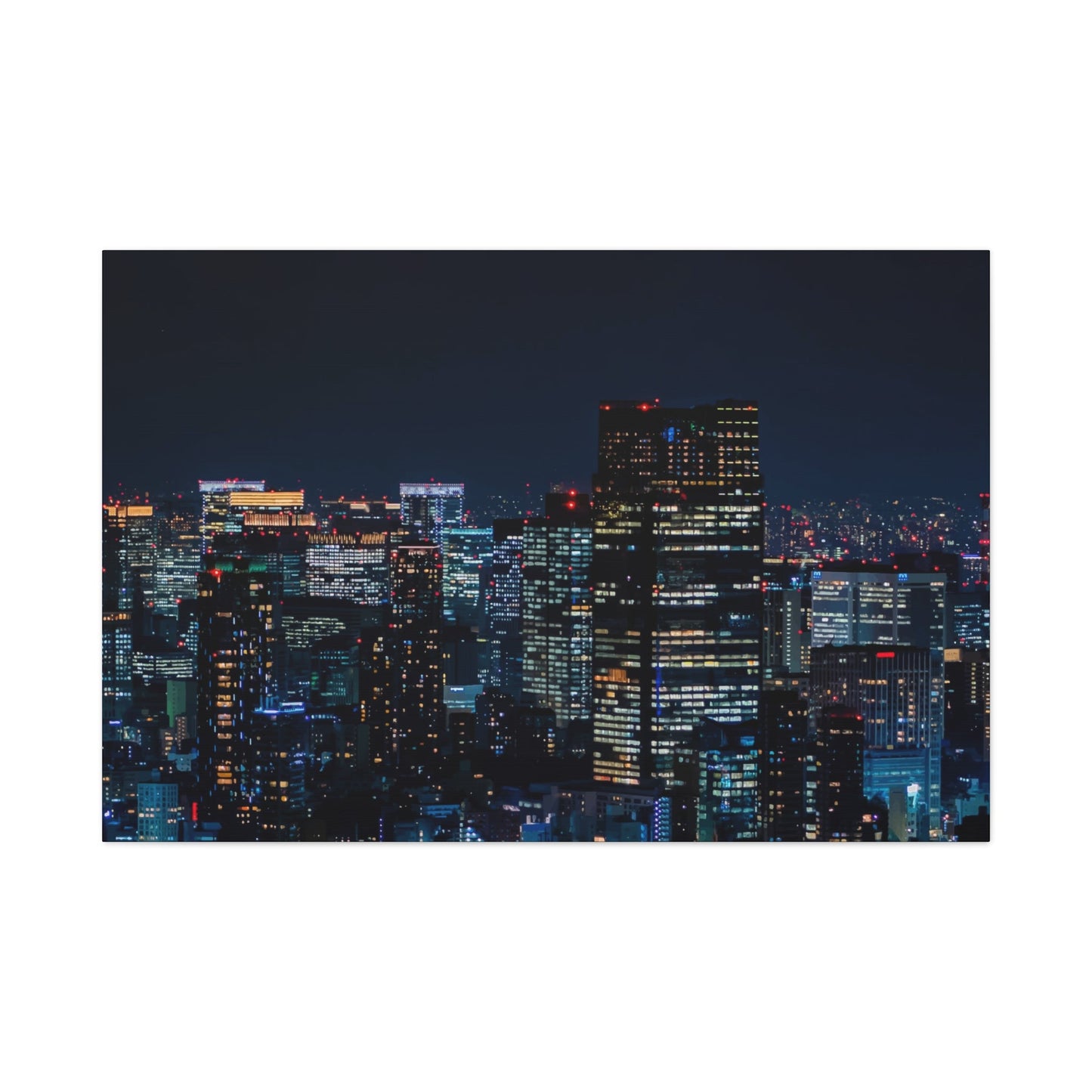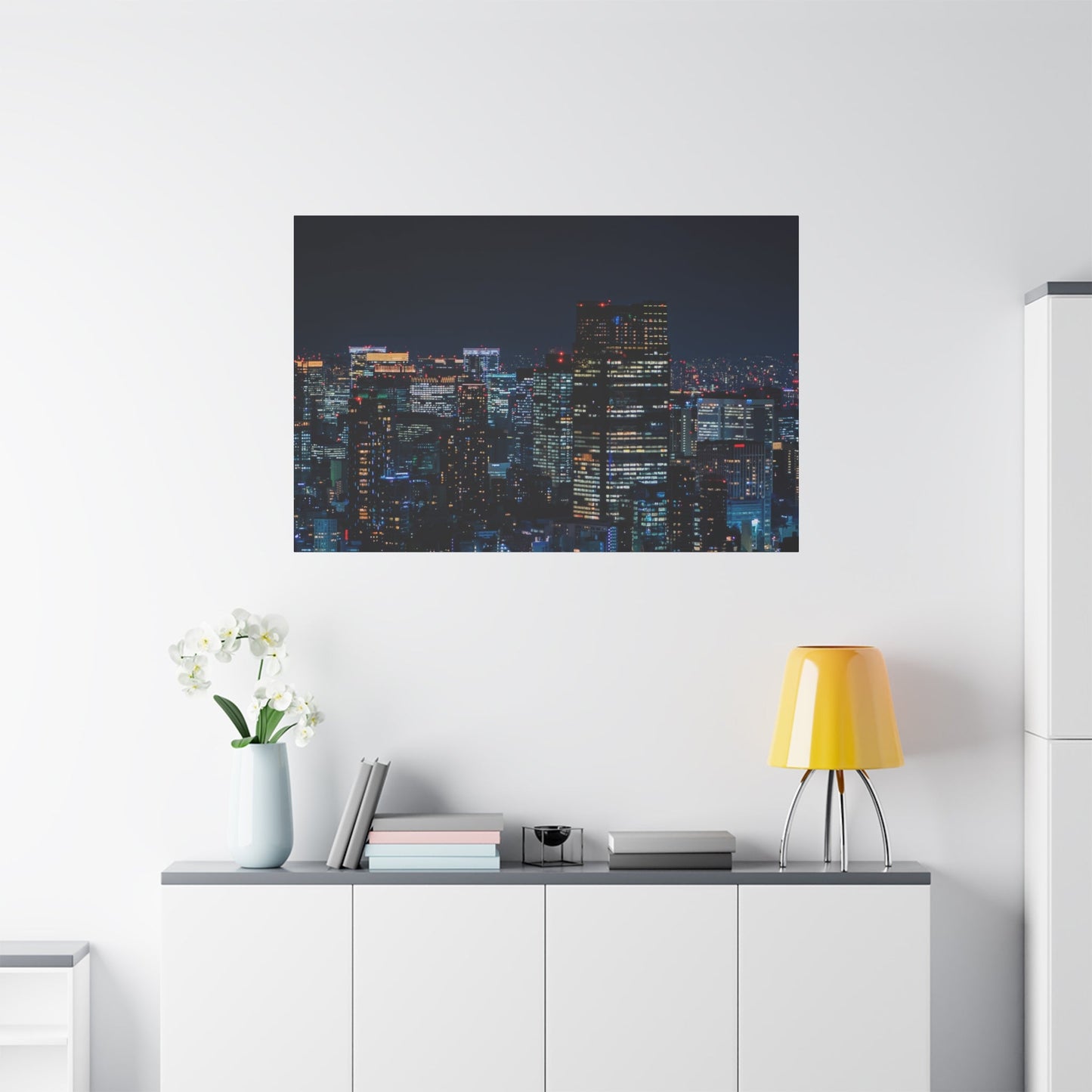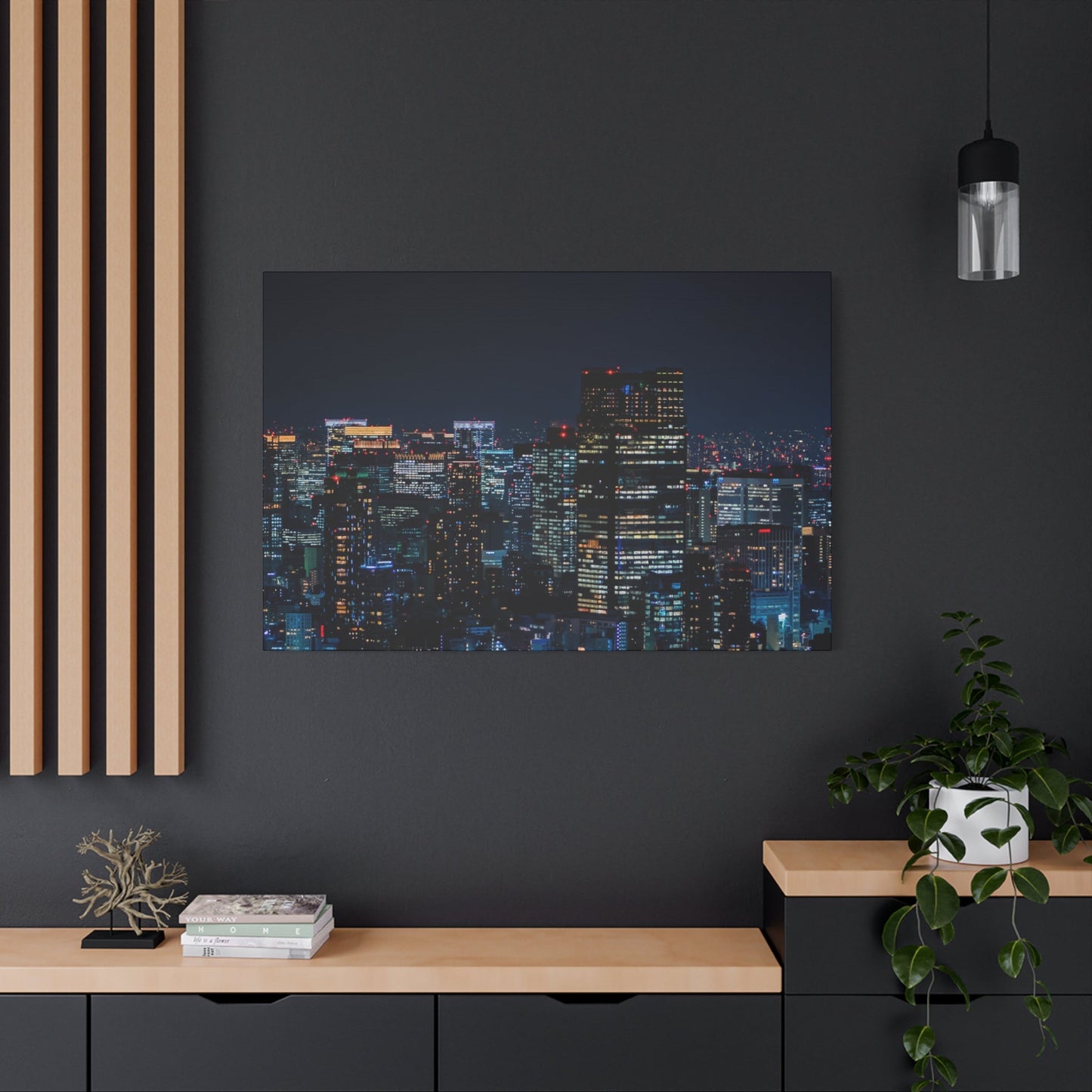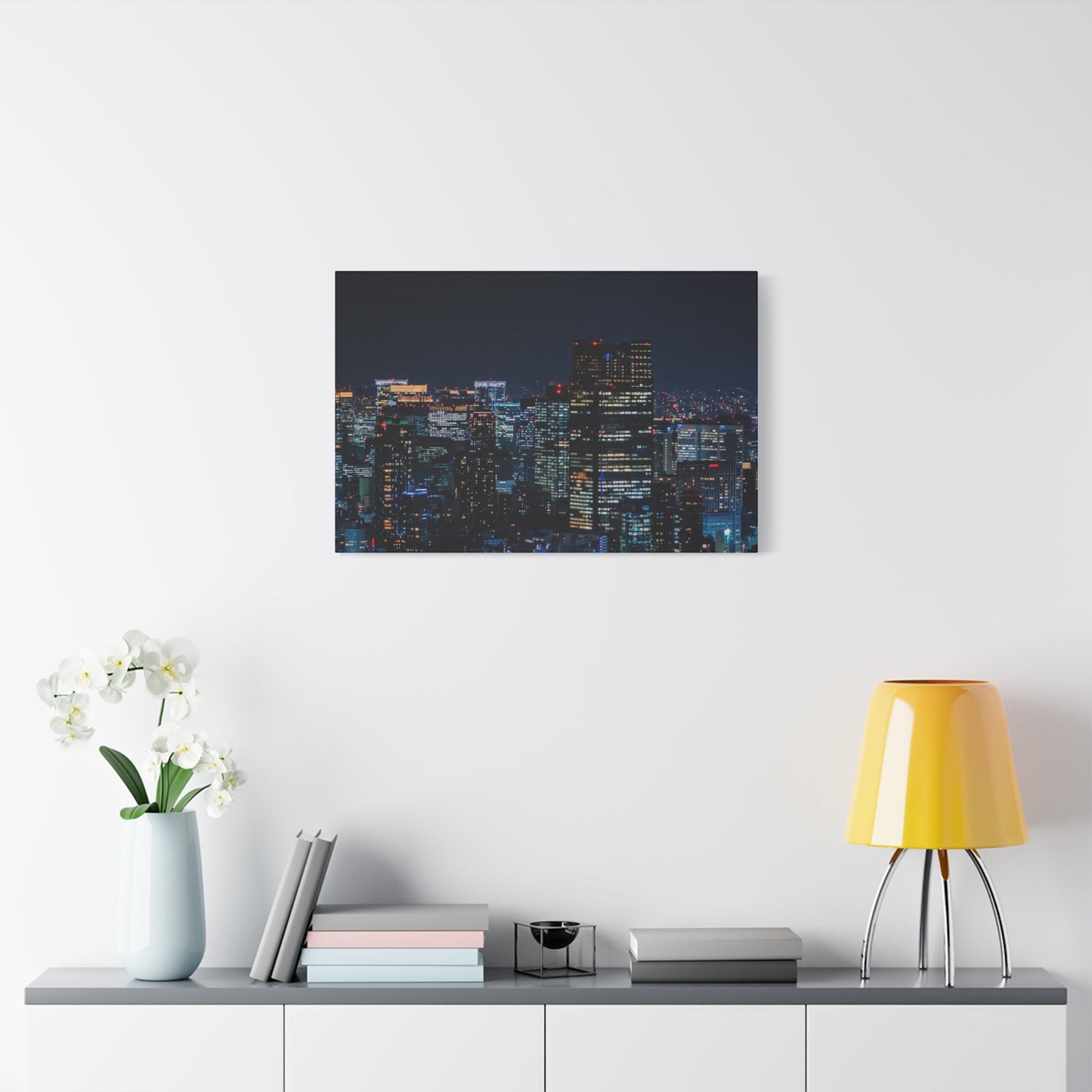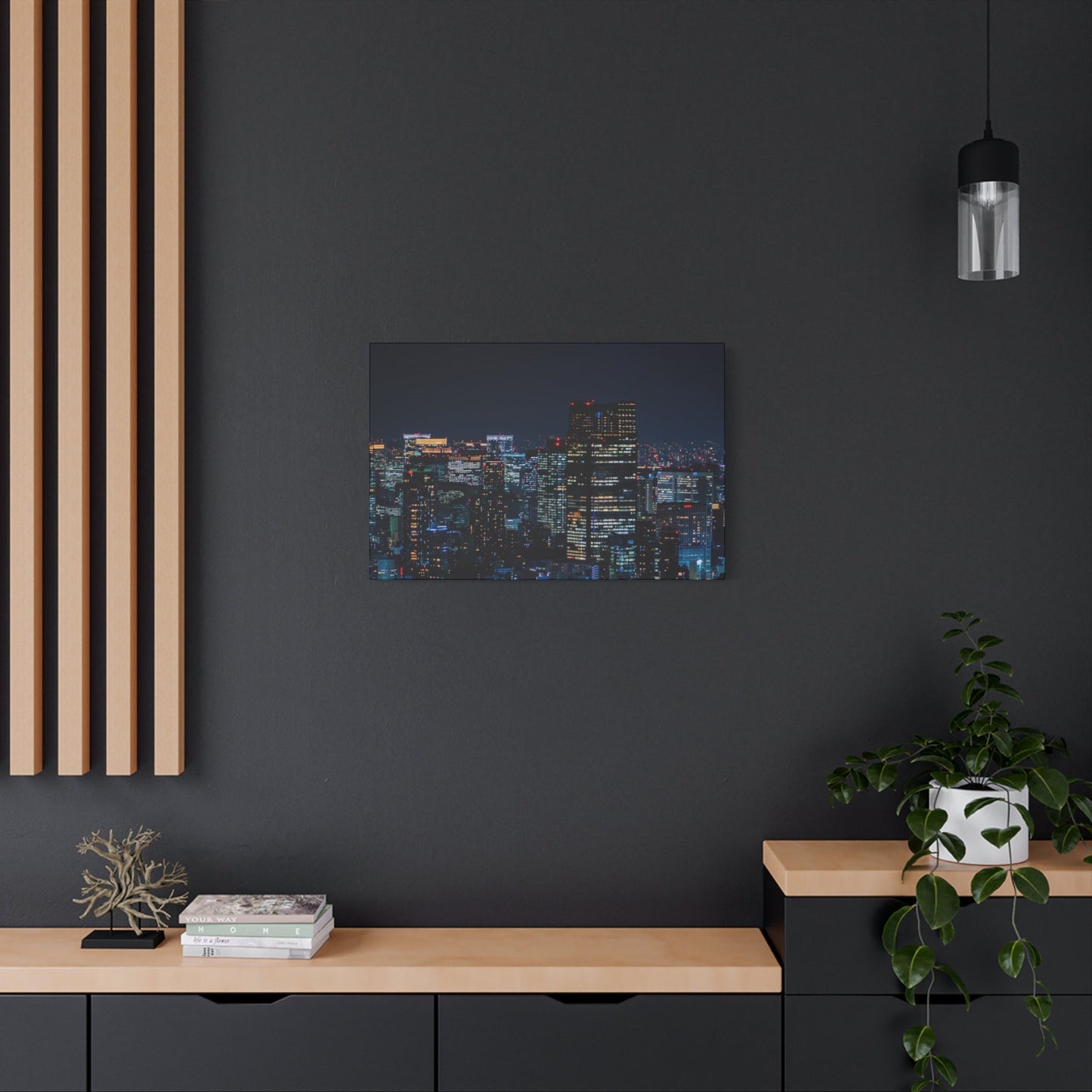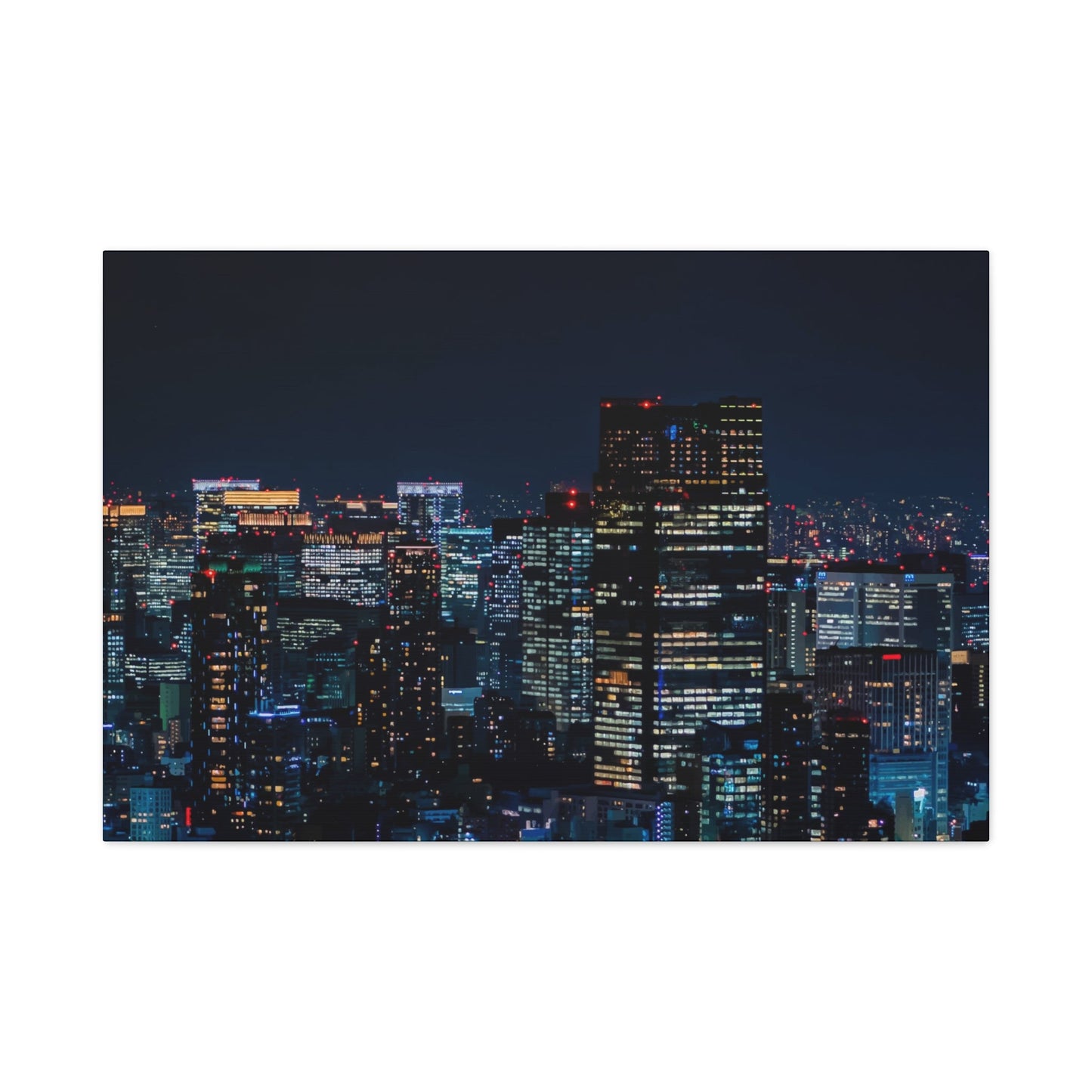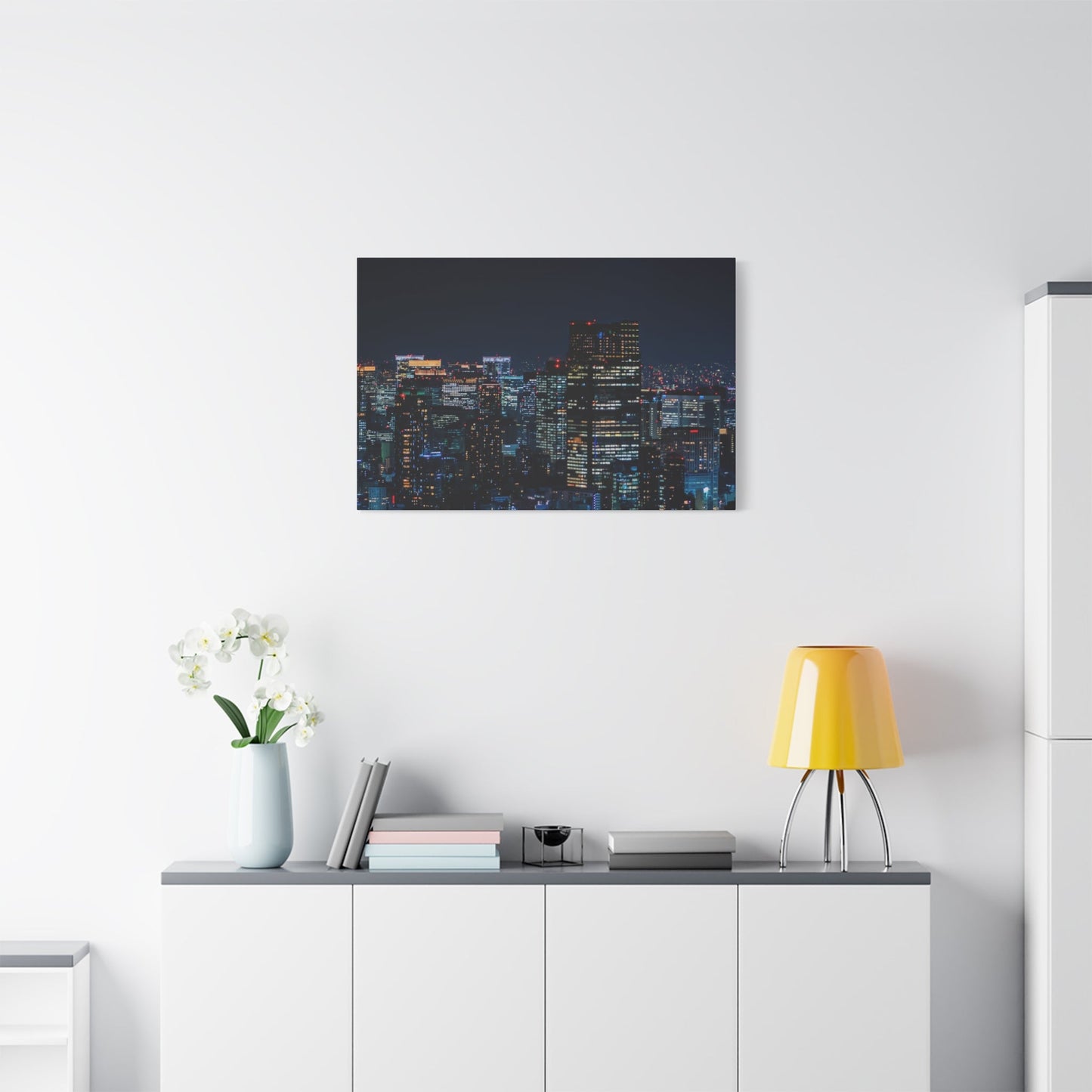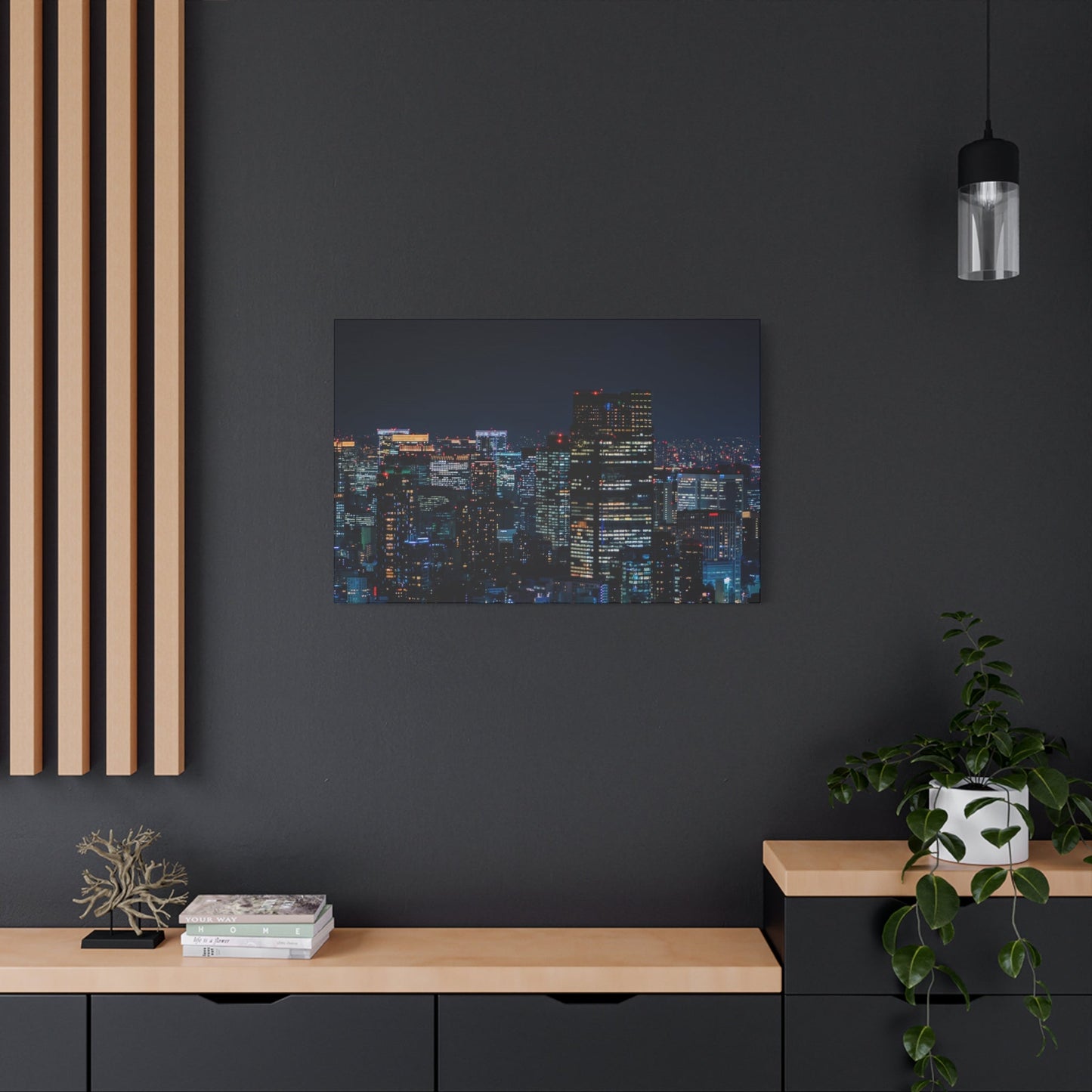Illuminate Your Home with Stunning Tokyo Night Views Wall Art
Tokyo's mesmerizing nocturnal landscape has captivated hearts and minds worldwide, creating an irresistible allure that transcends geographical boundaries. The Japanese capital transforms into a breathtaking canvas of light after sunset, with its iconic skyline painting stories of urban sophistication and cultural richness. This magnificent cityscape has become increasingly popular among homeowners seeking to infuse their living environments with metropolitan energy and contemporary elegance through carefully curated visual elements.
The fascination with Tokyo's nighttime scenery stems from its unique blend of traditional Japanese aesthetics and cutting-edge modernity. When darkness falls, the city reveals its true character through illuminated skyscrapers, neon-lit streets, and architectural marvels that create an almost otherworldly atmosphere. This captivating visual symphony has naturally found its way into homes across the globe, allowing residents to bring a piece of Japan's urban magnificence into their personal sanctuaries.
Contemporary homeowners increasingly recognize the transformative power of incorporating Tokyo's nocturnal beauty into their living environments. These stunning visual representations serve as more than mere decorative elements; they function as conversation starters, mood enhancers, and cultural bridges that connect personal environments with one of the world's most dynamic cities. The appeal lies not only in the aesthetic beauty but also in the emotional connection these images create with viewers who appreciate urban sophistication and cultural diversity.
The growing trend of featuring Tokyo's nighttime scenery in residential settings reflects a broader movement toward embracing global influences in home decoration. As people become more internationally minded and culturally curious, they seek ways to express their worldliness and appreciation for different cultures through their living environments. Tokyo's nighttime imagery perfectly fulfills this desire by offering a sophisticated, visually striking representation of contemporary urban life that resonates with modern sensibilities.
Embracing Urban Energy Through Tokyo's Nocturnal Canvas Masterpieces
The magnetic appeal of Tokyo at night lies in its extraordinary ability to showcase urban energy in its most refined form. The city's nighttime transformation creates a visual spectacle that combines technological advancement with artistic beauty, resulting in imagery that speaks to contemporary audiences seeking dynamic and engaging home environments. These captivating scenes capture the essence of metropolitan living while maintaining an aesthetic appeal that transcends cultural boundaries.
Tokyo's nocturnal landscape offers an unparalleled variety of visual elements that contribute to its widespread appeal in modern home decoration. From the bustling crosswalks of Shibuya to the serene illumination of traditional temples nestled between modern structures, each scene tells a unique story about the coexistence of past and present. This rich narrative quality makes these images particularly valuable for homeowners who appreciate art that carries deeper meaning beyond its surface beauty.
The urban energy captured in Tokyo's nighttime scenes provides homeowners with an opportunity to introduce dynamic elements into their living environments without overwhelming existing design schemes. The sophisticated color palettes typically found in these images, dominated by blues, purples, and golden yellows, complement a wide range of decorative styles while adding visual interest and cultural depth. This versatility makes Tokyo nighttime imagery an excellent choice for various residential settings, from minimalist modern apartments to eclectic contemporary homes.
The psychological impact of incorporating Tokyo's urban energy into personal living environments cannot be understated. These images often evoke feelings of excitement, possibility, and connection to a broader world beyond one's immediate surroundings. For many homeowners, particularly those with an affinity for travel or international culture, these visual elements serve as daily reminders of the world's diversity and beauty, creating positive emotional associations within their personal environments.
Furthermore, the technical quality and artistic composition found in contemporary Tokyo nighttime photography and artwork have reached exceptional standards, ensuring that these pieces function as legitimate art investments rather than simple decorative accessories. Many artists and photographers specializing in urban landscape imagery have developed sophisticated techniques for capturing the city's essence, resulting in works that demonstrate both technical proficiency and artistic vision.
Contemporary Home Styling Meets Japanese Metropolitan Illumination
The integration of Tokyo's nighttime cityscape into contemporary home styling represents a sophisticated approach to cultural appreciation and aesthetic enhancement. Modern homeowners increasingly seek decorative elements that reflect their global awareness and appreciation for international beauty, making Japanese metropolitan imagery an ideal choice for those wanting to create culturally rich living environments without resorting to clichéd or stereotypical representations.
Contemporary styling principles emphasize clean lines, functional beauty, and meaningful decorative choices that contribute to overall environmental harmony. Tokyo's nighttime scenery aligns perfectly with these principles by offering visually striking imagery that maintains sophisticated elegance while introducing cultural depth and international flair. The geometric patterns created by illuminated buildings and street layouts complement modern architectural elements commonly found in contemporary homes.
The color schemes prevalent in Tokyo's nocturnal landscape photography naturally harmonize with popular contemporary decorating approaches. The deep blues of twilight skies, warm golden tones from streetlights and building illumination, and occasional splashes of neon colors create a palette that works seamlessly with neutral contemporary color schemes while adding visual interest and emotional warmth. This compatibility makes it relatively easy to incorporate these images into existing decorative frameworks without major adjustments to surrounding elements.
Scale and proportion play crucial roles in successfully integrating Tokyo cityscape imagery into contemporary home environments. Large-format presentations of nighttime scenes can serve as dramatic focal points in living rooms or dining areas, while smaller pieces work effectively in bedroom settings or hallway galleries. The key lies in selecting appropriate sizes that complement room proportions while ensuring the imagery maintains its visual impact and cultural significance.
The material choices available for displaying Tokyo nighttime imagery have expanded significantly, offering homeowners numerous options for achieving their desired aesthetic goals. Canvas presentations provide texture and artistic legitimacy, while metal prints offer modern sophistication and enhanced color vibrancy. Glass mounting techniques create floating effects that emphasize the ethereal quality of nighttime illumination, while traditional framing approaches allow for customization that matches existing decorative elements.
Lighting considerations become particularly important when displaying Tokyo nighttime scenes, as proper illumination can enhance the dramatic qualities inherent in these images while creating atmospheric effects that complement the subject matter. Strategically placed accent lighting can highlight specific elements within the imagery while creating subtle environmental effects that echo the original scene's luminous qualities.
Capturing the Luminous Essence of Japanese Urban Nights
The art of capturing Tokyo's luminous nighttime essence requires both technical expertise and cultural sensitivity, resulting in imagery that transcends simple documentation to become genuine artistic expression. Professional photographers and artists who specialize in Japanese urban landscapes have developed sophisticated approaches to representing the city's unique character, combining technical mastery with deep appreciation for the cultural and aesthetic elements that make Tokyo's nighttime scenes so compelling.
The technical challenges involved in capturing Tokyo's nighttime beauty are considerable, requiring expertise in low-light photography, long exposure techniques, and post-processing methods that enhance natural beauty while maintaining authenticity. The most successful images balance the artificial illumination of urban environments with natural elements like sky color and atmospheric conditions, creating compositions that feel both dramatic and realistic.
Color accuracy and enhancement play crucial roles in creating compelling Tokyo nighttime imagery that works effectively in residential settings. The interplay between artificial lighting sources creates complex color relationships that must be carefully managed to achieve visually pleasing results. Skilled artists and photographers understand how to emphasize the warm golden tones of traditional lighting while balancing the cooler blues and purples of modern illumination systems.
Composition techniques used in capturing Tokyo's nighttime scenes often employ principles derived from traditional Japanese aesthetics, including careful attention to balance, harmony, and the strategic use of negative elements. These compositional approaches result in images that feel both contemporary and culturally grounded, making them particularly suitable for homeowners seeking art that demonstrates cultural appreciation and aesthetic sophistication.
The perspective choices available when documenting Tokyo's nighttime landscape range from intimate street-level views that capture human-scale details to sweeping panoramic vistas that showcase the city's vast scope and complexity. Each approach offers different emotional and aesthetic qualities, allowing homeowners to select imagery that aligns with their personal preferences and decorative goals.
Post-processing techniques used in creating compelling Tokyo nighttime artwork often emphasize the dramatic contrasts between light and shadow while enhancing color saturation in ways that maintain natural appearance. The goal is to create images that capture the emotional impact of experiencing Tokyo at night while ensuring technical quality that allows for high-quality reproduction in residential settings.
Metropolitan Glow: Bringing Tokyo's Energy Into Personal Living Environments
The concept of incorporating Tokyo's metropolitan glow into personal living environments extends beyond simple decoration to encompass lifestyle enhancement and cultural enrichment. These luminous urban scenes carry emotional and psychological benefits that contribute to creating living environments that feel dynamic, internationally connected, and aesthetically sophisticated. The energy inherent in Tokyo's nighttime imagery can transform static residential environments into engaging, inspiring personal retreats.
The psychological impact of surrounding oneself with images of vibrant urban energy has been documented in various studies exploring the relationship between visual environment and emotional well-being. Tokyo's nighttime scenes, with their combination of human activity, architectural beauty, and technological sophistication, can create positive associations with progress, possibility, and cultural diversity that enhance daily living experiences.
The versatility of Tokyo's metropolitan imagery allows for creative integration into various residential environments, from compact urban apartments to spacious suburban homes. The key lies in selecting appropriate scales and presentation methods that complement existing architectural elements while maximizing the visual impact of these compelling scenes. Large-format presentations work particularly well in open-concept living areas where they can serve as dramatic focal points.
Creating cohesive decorative schemes that incorporate Tokyo nighttime imagery requires careful consideration of complementary elements that enhance rather than compete with the primary visual statement. Furniture selections, lighting choices, and accessory placements should work together to create environments that feel intentionally curated rather than accidentally assembled. The goal is to create living environments that feel both sophisticated and personally meaningful.
The cultural significance of incorporating Japanese urban imagery into personal living environments extends beyond aesthetic considerations to encompass broader themes of global awareness and cultural appreciation. For many homeowners, these visual elements represent connections to experiences, aspirations, or cultural interests that add personal meaning to their living environments beyond simple decorative value.
Maintenance and longevity considerations become important factors when investing in Tokyo nighttime imagery for residential use. High-quality printing methods, appropriate framing materials, and strategic placement away from direct sunlight or high-humidity areas help ensure these artistic investments maintain their visual impact and economic value over time.
Iconic Japanese Cityscapes: From Shibuya's Bustling Energy to Skytree's Majestic Presence
Tokyo's most iconic nighttime locations offer distinct aesthetic and emotional qualities that appeal to different decorative preferences and lifestyle aspirations. From the human energy of Shibuya crossing to the architectural magnificence of Tokyo Skytree, each location provides unique visual elements that can enhance residential environments in specific ways. Understanding these distinctions helps homeowners make informed choices about which Tokyo nighttime scenes best complement their personal style and decorative goals.
Shibuya crossing represents the human side of Tokyo's urban energy, capturing the intersection of individual lives within a larger metropolitan context. Images focusing on this iconic location often emphasize movement, diversity, and the beautiful choreography of urban life. The warm lighting from surrounding buildings creates inviting color palettes that work particularly well in social areas of homes where human connection and energy are valued.
The Tokyo Skytree offers a different aesthetic experience, emphasizing architectural achievement and technological sophistication against the night sky. Images featuring this modern landmark often showcase clean geometric lines and sophisticated lighting effects that complement contemporary decorative schemes. The tower's illumination system, which changes colors according to seasons and special occasions, provides opportunities for imagery that captures specific moments or celebratory themes.
Traditional neighborhoods like Asakusa provide opportunities for imagery that balances historical elements with contemporary urban energy. These areas showcase Tokyo's cultural depth while maintaining the dynamic energy that characterizes the modern city. Nighttime scenes from these locations often feature traditional architecture illuminated by modern lighting, creating visual narratives about cultural continuity and adaptation.
The Ginza district offers imagery that emphasizes luxury, sophistication, and commercial energy. Nighttime scenes from this area often feature elegant architectural elements, sophisticated lighting design, and an atmosphere of metropolitan refinement that appeals to homeowners seeking to create luxurious residential environments with international flair.
Residential neighborhoods and side streets provide more intimate perspectives on Tokyo's nighttime character, focusing on human-scale details and everyday beauty rather than grand architectural statements. These images often work well in bedroom settings or smaller residential areas where more personal, intimate atmospheres are desired.
Brilliant Urban Illumination: Transforming Residential Environments with City Lighting
The transformative power of Tokyo's urban illumination extends far beyond simple visual appeal to encompass fundamental changes in how residential environments feel and function. The strategic incorporation of cityscape imagery featuring brilliant illumination can alter spatial perception, enhance mood, and create dynamic focal points that energize entire living areas. Understanding how different lighting elements within Tokyo nighttime scenes affect residential environments helps homeowners make informed decisions about incorporating these powerful visual elements.
The layered lighting effects commonly found in Tokyo nighttime photography create depth and visual interest that can make residential rooms feel more spacious and engaging. Images that capture multiple lighting sources at different distances create atmospheric perspective that draws viewers into the scene while adding visual complexity to otherwise simple room layouts. This effect is particularly valuable in smaller residential environments where creating the illusion of greater depth enhances overall comfort and livability.
Color temperature variations within Tokyo's urban lighting create opportunities for complementing existing residential lighting schemes while adding visual interest. The warm golden tones from traditional incandescent sources contrast beautifully with cooler LED illumination, creating color relationships that can be echoed in residential lighting design to create cohesive environmental themes that connect artificial lighting with visual art.
The contrast between illuminated and shadowed areas in Tokyo nighttime scenes creates dramatic visual effects that can serve as inspiration for residential lighting design. Strategic placement of accent lighting near cityscape imagery can create layered lighting effects that echo the dramatic contrasts found in the artwork while enhancing the overall atmospheric quality of residential environments.
Seasonal variations in Tokyo's urban illumination provide opportunities for imagery that reflects changing moods and atmospheric conditions throughout the year. Winter scenes with warm interior lighting contrasting against cool exterior conditions create cozy, inviting feelings that work particularly well in family areas and bedrooms. Summer scenes with vibrant neon colors and active street life can energize social areas and home offices.
The reflection of urban lighting on wet surfaces, a common element in Tokyo nighttime photography, creates visual effects that add movement and life to static images. These reflective qualities can make residential rooms feel more dynamic and engaging while adding visual complexity that rewards closer examination and appreciation.
Contemporary Living Enhancement Through Japanese Urban Landscapes
The integration of Japanese urban landscapes into contemporary living environments represents a sophisticated approach to residential enhancement that goes beyond traditional decorative strategies. These compelling visual elements serve multiple functions within modern homes, acting as cultural ambassadors, conversation catalysts, and sources of daily inspiration that enrich the overall living experience. The careful selection and presentation of Tokyo nighttime imagery can transform ordinary residential rooms into culturally rich, aesthetically sophisticated personal retreats.
Contemporary living often emphasizes the importance of creating personally meaningful environments that reflect individual interests, experiences, and aspirations. Japanese urban landscapes provide opportunities for homeowners to express their appreciation for international culture, urban sophistication, and artistic beauty through carefully curated visual elements that demonstrate cultural awareness and aesthetic discernment.
The minimalist aesthetic principles that characterize much of contemporary residential design find natural harmony with the clean lines and sophisticated composition commonly found in Tokyo nighttime photography. The geometric patterns created by illuminated buildings, the careful balance between positive and negative elements, and the sophisticated color relationships all align with contemporary design principles while adding cultural depth and visual interest.
Functional considerations play important roles in successfully incorporating Japanese urban landscapes into contemporary living environments. These images work particularly well in areas where residents and guests spend significant time, such as living rooms, dining areas, and home offices. The engaging nature of urban scenes provides visual interest that can enhance social interactions and create positive environmental associations.
The psychological benefits of incorporating dynamic urban imagery into residential environments include increased feelings of connection to broader world communities, enhanced appreciation for cultural diversity, and daily reminders of the beauty that exists in human-created environments. These positive associations can contribute to overall residential satisfaction and personal well-being.
Scale and proportion considerations become particularly important when integrating Japanese urban landscapes into contemporary living environments. Large-format presentations can serve as dramatic focal points that anchor entire room designs, while smaller pieces work effectively as elements within larger gallery arrangements that tell broader stories about international appreciation and cultural curiosity.
Creating Atmospheric Home Environments with Tokyo's Nocturnal Beauty
The atmospheric qualities inherent in Tokyo's nocturnal beauty offer homeowners unique opportunities to create residential environments that feel both sophisticated and emotionally engaging. The interplay of light, shadow, color, and architectural elements found in nighttime Tokyo scenes can inspire comprehensive decorative approaches that transform ordinary rooms into extraordinary personal environments that reflect cultural appreciation and aesthetic sophistication.
Atmospheric lighting design inspired by Tokyo's nighttime illumination can create residential environments that feel both contemporary and culturally grounded. The layered lighting effects commonly found in urban photography can be translated into residential lighting schemes that use multiple light sources at different intensities and color temperatures to create depth, interest, and emotional warmth within personal living environments.
Color palette development based on Tokyo nighttime imagery provides frameworks for creating cohesive residential decorating schemes that feel both sophisticated and personally meaningful. The deep blues, warm golds, and occasional accent colors found in urban nighttime scenes can be used as inspiration for paint colors, fabric selections, and accessory choices that create harmonious residential environments with international flair.
Texture and material selections inspired by urban architectural elements can add tactile interest to residential environments while reinforcing cultural themes introduced through visual art. Smooth surfaces that echo modern architectural materials, contrasted with softer textile elements that provide comfort and warmth, create balanced environments that feel both sophisticated and livable.
The seasonal qualities found in Tokyo nighttime imagery can inspire residential decorating approaches that change throughout the year, keeping living environments fresh and engaging while maintaining consistent cultural and aesthetic themes. This approach allows homeowners to enjoy variety within their personal environments while developing deeper appreciation for the cyclical beauty found in urban landscapes.
Furniture and accessory selections that complement Tokyo nighttime imagery should emphasize clean lines, functional beauty, and cultural sensitivity. Pieces that reflect Japanese design principles, combined with contemporary elements that maintain comfort and functionality, create residential environments that feel authentically influenced by Japanese culture without resorting to superficial stereotypes.
Sophisticated Gallery Presentation Techniques for Urban Landscape Photography
The presentation of Tokyo urban landscape photography in residential settings requires careful consideration of framing, mounting, lighting, and placement techniques that maximize visual impact while maintaining artistic integrity. Professional presentation methods can transform compelling photography into gallery-quality art installations that serve as focal points within residential environments while demonstrating appreciation for both photographic artistry and Japanese culture.
Framing selections for Tokyo nighttime photography should complement both the imagery and existing residential decorative elements while maintaining focus on the photographic content. Sleek, minimal frames often work best with contemporary urban photography, as they avoid competing with the complex visual elements within the images while providing necessary structure and protection. Material choices should consider durability, aesthetic compatibility, and maintenance requirements.
Mounting techniques significantly affect how Tokyo urban photography appears within residential settings. Canvas mounting provides texture and artistic legitimacy that emphasizes the artistic nature of the photography, while metal mounting creates contemporary sophistication with enhanced color vibrancy. Acrylic mounting offers modern elegance with enhanced depth perception that can make images appear to float within their environments.
Lighting design for showcasing Tokyo nighttime photography requires careful consideration of color temperature, intensity, and positioning to enhance the dramatic qualities inherent in urban landscape imagery. Accent lighting should complement rather than compete with the illumination depicted within the photographs, creating layered lighting effects that honor the original scenes while enhancing their impact within residential environments.
Placement strategies for Tokyo urban photography should consider viewing angles, traffic patterns, and relationship to other decorative elements within residential environments. Images should be positioned where they can be appreciated both as individual artworks and as elements within larger decorative compositions that contribute to overall environmental harmony and cultural coherence.
Grouping multiple Tokyo nighttime images can create compelling gallery walls that tell comprehensive stories about the city's beauty and cultural significance. Careful attention to scale relationships, visual flow, and thematic coherence ensures that multiple pieces work together to create unified artistic statements rather than competing for attention within residential environments.
Global Design Integration: Incorporating International Urban Aesthetics
The incorporation of Tokyo's urban aesthetics into residential environments represents a broader trend toward global design integration that reflects contemporary homeowners' increasing international awareness and cultural curiosity. This approach to residential decorating emphasizes the thoughtful integration of international influences that enhance personal living environments while demonstrating cultural appreciation and global perspective.
Global design integration requires sensitivity to cultural authenticity while avoiding stereotypical or superficial representations that fail to honor the cultures being referenced. Tokyo nighttime imagery offers opportunities for genuine cultural appreciation that goes beyond surface-level decorative choices to encompass deeper understanding of Japanese aesthetic principles, urban planning philosophy, and contemporary cultural expression.
Balancing international influences with personal style preferences requires careful consideration of how global elements integrate with existing decorative frameworks and lifestyle requirements. Tokyo urban aesthetics can complement various contemporary decorating approaches while adding cultural depth and visual interest that enhances overall residential environments without overwhelming personal expression or functional needs.
The educational value of incorporating international urban aesthetics extends beyond simple decoration to encompass ongoing cultural learning and appreciation. Tokyo nighttime imagery can serve as starting points for deeper exploration of Japanese culture, urban planning principles, and contemporary art movements that enrich personal understanding while enhancing residential environments.
Contemporary homeowners increasingly seek decorative approaches that reflect their values, interests, and global awareness. Tokyo urban aesthetics provide opportunities for expressing appreciation for cultural diversity, urban sophistication, and artistic beauty through carefully curated visual elements that demonstrate thoughtful cultural engagement rather than superficial decorative choices.
Quality considerations become particularly important when incorporating international urban aesthetics into residential environments. Investment in high-quality photography, professional presentation methods, and appropriate placement ensures that these cultural elements maintain their visual impact and educational value over time while contributing to overall residential value and personal satisfaction.
Therapeutic Benefits of Urban Landscape Visual Elements in Home Environments
The psychological and therapeutic benefits of incorporating urban landscape visual elements into residential environments have been increasingly recognized by environmental psychology researchers and residential design professionals. Tokyo's nighttime cityscapes offer particular therapeutic value through their combination of visual complexity, cultural richness, and emotional resonance that can contribute to enhanced well-being within personal living environments.
Visual complexity found in Tokyo urban landscapes provides cognitive stimulation that can enhance mental engagement and prevent environmental monotony within residential settings. The layered visual elements, varied lighting effects, and architectural diversity found in these scenes offer ongoing visual interest that can reduce feelings of residential confinement while providing daily sources of aesthetic appreciation and cultural connection.
Stress reduction benefits associated with viewing compelling urban imagery stem from the escapist qualities these scenes provide, offering mental transportation to different environments and cultural contexts. For homeowners dealing with daily pressures or limited travel opportunities, Tokyo nighttime scenes can provide psychological relief through their capacity to evoke feelings of adventure, possibility, and connection to broader world communities.
The inspirational qualities inherent in urban achievement imagery can contribute to enhanced motivation and positive outlook within residential environments. Tokyo's impressive architectural and technological accomplishments, as depicted in nighttime photography, can serve as daily reminders of human capability and cultural achievement that inspire personal growth and appreciation for global progress.
Cultural enrichment provided by international urban imagery contributes to expanded worldview and enhanced cultural sensitivity that benefits personal development while creating more interesting residential environments. Regular exposure to different cultural aesthetics can enhance appreciation for diversity while providing ongoing opportunities for learning and cultural exploration.
Sleep quality improvements have been reported by some individuals who incorporate calming urban imagery into bedroom environments, particularly scenes that emphasize the peaceful qualities of nighttime urban environments rather than their energetic aspects. Carefully selected Tokyo nighttime imagery can create restful atmospheric effects that support relaxation and sleep preparation.
Artistic Investment Value and Long-Term Residential Enhancement
The consideration of Tokyo nighttime imagery as artistic investment represents a sophisticated approach to residential enhancement that combines aesthetic appreciation with financial prudence. High-quality urban landscape photography and artwork can provide long-term value through their dual function as decorative elements and legitimate art investments that appreciate over time while enhancing residential environments and personal satisfaction.
Market trends in urban landscape photography indicate increasing collector interest in high-quality cityscapes, particularly those documenting rapidly changing metropolitan environments like Tokyo. The city's continuous architectural evolution and cultural significance make contemporary documentation of its nighttime character particularly valuable for collectors and homeowners who appreciate both artistic merit and historical documentation.
Artist reputation and technical quality significantly affect the investment potential of Tokyo nighttime imagery. Works by established photographers with documented exhibition histories and critical recognition typically maintain better long-term value than mass-produced decorative prints, making careful artist selection important for homeowners seeking both aesthetic enhancement and investment value.
Limited edition considerations add exclusivity and investment potential to Tokyo urban landscape imagery. Numbered editions with certificates of authenticity provide collector value while ensuring that homeowners possess unique artistic elements that distinguish their residential environments from mass-market decorative approaches.
Condition maintenance requirements for preserving artistic investment value include appropriate framing with archival materials, controlled lighting exposure, and environmental conditions that prevent fading, moisture damage, or other deterioration that could affect both aesthetic appeal and financial value over time.
Documentation and provenance records contribute to long-term investment value by providing authentication and historical context that enhance collector appeal. Maintaining purchase receipts, artist information, and exhibition documentation helps preserve both financial and cultural value while supporting potential future resale opportunities.
Seasonal Decorating Approaches with Tokyo Urban Imagery
The incorporation of seasonal elements within Tokyo urban imagery provides opportunities for dynamic residential decorating approaches that change throughout the year while maintaining consistent cultural and aesthetic themes. Tokyo's distinct seasonal characteristics, captured in nighttime photography, can inspire residential decorating strategies that keep living environments fresh and engaging while honoring Japanese cultural traditions of seasonal awareness and appreciation.
Spring imagery featuring Tokyo's famous cherry blossoms illuminated against urban backdrops creates opportunities for residential decorating approaches that celebrate renewal, growth, and natural beauty within metropolitan contexts. These scenes often feature delicate pink blooms contrasted against modern architecture, providing color palettes and thematic inspiration for residential decorating that feels both contemporary and culturally grounded.
Summer scenes capturing Tokyo's festival energy and vibrant street life can inspire residential decorating approaches that emphasize celebration, community, and cultural vitality. The warm lighting and active human elements commonly found in summer nighttime photography create opportunities for decorating themes that enhance social areas and create welcoming residential environments.
Autumn imagery showcasing Tokyo's changing foliage against illuminated urban backgrounds provides inspiration for residential decorating that emphasizes warmth, sophistication, and the beauty of transition. The rich color palettes found in autumn urban scenes often feature deep reds, golden yellows, and warm browns that create cozy residential environments perfect for cooler months.
Winter scenes featuring Tokyo's illuminated architecture against snowy backgrounds create opportunities for residential decorating that emphasizes elegance, serenity, and the beauty found in contrast between warm interior environments and cool exterior conditions. These images often inspire decorating approaches that emphasize comfort and warmth while maintaining sophisticated aesthetic standards.
Rotating seasonal displays of Tokyo urban imagery allows homeowners to enjoy variety within their residential environments while developing deeper appreciation for the cyclical beauty found in urban landscapes. This approach requires careful planning and storage but provides ongoing opportunities for environmental refresh and cultural exploration.
Cultural Sensitivity and Authentic Representation in Home Decoration
The incorporation of Tokyo urban imagery into residential environments requires careful attention to cultural sensitivity and authentic representation that honors Japanese culture while avoiding stereotypical or superficial interpretations. Responsible cultural appreciation through home decoration involves understanding the deeper meanings and contexts behind visual elements while making decorative choices that demonstrate genuine respect and cultural awareness.
Authentic representation begins with selecting Tokyo nighttime imagery that accurately portrays the city's contemporary reality rather than romanticized or stereotypical interpretations that may perpetuate cultural misunderstandings. High-quality photography by reputable artists who demonstrate cultural knowledge and sensitivity provides the foundation for responsible cultural appreciation through residential decoration.
Cultural education opportunities arise naturally through the incorporation of authentic Tokyo urban imagery, providing homeowners and their guests with starting points for learning about Japanese culture, urban planning principles, and contemporary social dynamics. These educational aspects add depth and meaning to decorative choices while supporting broader cultural understanding and appreciation.
Avoiding cultural appropriation requires understanding the difference between appreciation and appropriation while making decorative choices that honor rather than exploit cultural elements. Tokyo urban imagery, particularly when selected and presented with cultural sensitivity, offers opportunities for genuine appreciation that celebrates Japanese culture without reducing it to superficial decorative elements.
Supporting authentic cultural representation through purchasing decisions involves seeking out work by Japanese artists or photographers with direct cultural connections to Tokyo, ensuring that economic benefits from cultural appreciation flow back to communities being celebrated. This approach supports authentic cultural expression while enhancing residential environments with genuinely meaningful artistic elements.
Community engagement opportunities may arise through cultural appreciation expressed in residential environments, providing natural starting points for deeper cultural learning, community connections with Japanese cultural organizations, and ongoing exploration of international understanding through personal living environments.
Technical Considerations for Displaying Urban Photography in Residential Settings
The successful display of Tokyo urban photography in residential settings requires attention to technical considerations that affect both visual impact and long-term preservation of artistic investments. Understanding the relationship between image quality, presentation methods, and environmental factors helps homeowners make informed decisions that maximize both aesthetic appeal and artistic longevity within their personal living environments.
Resolution and print quality considerations become particularly important when displaying urban photography in residential settings where images will be viewed at close range over extended periods. High-resolution files and professional printing methods ensure that fine details remain crisp and colors remain accurate, contributing to long-term satisfaction and artistic credibility within residential environments.
Color management throughout the printing and display process affects how Tokyo nighttime imagery appears under different residential lighting conditions. Professional color calibration ensures that printed images accurately represent the photographer's artistic intent while maintaining visual appeal under various lighting scenarios commonly found in residential environments.
Paper and substrate choices significantly affect both the appearance and longevity of displayed urban photography. Archival quality materials prevent fading and deterioration while different surface textures can enhance specific aspects of urban imagery, from the smooth reflective qualities that emphasize urban lighting to textured surfaces that add tactile interest.
Environmental factors within residential settings, including humidity levels, temperature fluctuations, and light exposure, affect the long-term preservation of displayed photography. Strategic placement away from direct sunlight, heating vents, and high-humidity areas helps preserve artistic investments while maintaining visual appeal over time.
Protective measures, including appropriate framing with UV-filtering glazing and archival mounting materials, contribute to long-term preservation while enhancing presentation quality. These technical considerations represent important investments in both aesthetic appeal and financial value preservation for homeowners committed to maintaining high-quality artistic elements within their living environments.
Complementary Design Elements That Enhance Tokyo Urban Themes
The successful integration of Tokyo urban imagery into residential environments benefits from careful selection of complementary design elements that reinforce cultural themes while maintaining aesthetic harmony and functional utility. Understanding how furniture, lighting, textiles, and accessories can work together to support Tokyo urban themes helps homeowners create cohesive residential environments that feel intentionally curated rather than accidentally assembled.
Furniture selections that complement Tokyo urban themes often emphasize clean lines, functional design, and quality craftsmanship that reflect Japanese aesthetic principles while maintaining contemporary comfort and utility. Pieces that demonstrate attention to detail, innovative design solutions, and cultural sensitivity can enhance urban themes while providing practical functionality within residential environments.
Lighting design inspired by Tokyo's sophisticated urban illumination can create atmospheric effects that complement displayed photography while enhancing overall residential ambiance. Layered lighting approaches using multiple sources at different intensities and color temperatures can echo the complex lighting relationships found in urban nighttime scenes.
Textile selections including window treatments, upholstery, and decorative elements can support Tokyo urban themes through color relationships, texture contrasts, and cultural references that feel authentic rather than stereotypical. Subtle incorporation of traditional Japanese textile techniques or contemporary interpretations can add cultural depth without overwhelming residential environments.
Accessory choices that support Tokyo urban themes might include contemporary ceramics, minimalist sculptural elements, or carefully selected cultural artifacts that demonstrate genuine appreciation rather than superficial decoration. Quality and authenticity should guide selection decisions to maintain cultural sensitivity while enhancing overall residential environments.
Plant selections inspired by Japanese gardening principles can provide natural elements that soften urban themes while maintaining cultural coherence. Strategic placement of appropriate plants can create visual bridges between urban photography and living residential environments while adding natural beauty and air quality benefits.
Professional Consultation and Curation Services for Urban Art Integration
The complexity of successfully integrating Tokyo urban imagery into residential environments often benefits from professional consultation and curation services that provide expertise in cultural sensitivity, aesthetic harmony, and technical presentation. Professional services can help homeowners navigate the numerous decisions involved in creating culturally rich residential environments while avoiding common pitfalls that might diminish aesthetic impact or cultural authenticity.
Interior design professionals with experience in international cultural integration can provide valuable guidance on selecting appropriate Tokyo urban imagery, determining optimal placement strategies, and coordinating complementary design elements that create cohesive residential environments. Their expertise in balancing cultural elements with personal style preferences can result in residential environments that feel both sophisticated and personally meaningful.
Art consultants specializing in urban landscape photography can provide access to high-quality works by reputable artists while offering guidance on artistic merit, investment potential, and cultural authenticity. Their knowledge of current market trends and emerging artists can help homeowners make informed decisions that balance aesthetic preferences with long-term value considerations.
Cultural consultants can provide educational context and sensitivity guidance that enhances appreciation while ensuring respectful cultural representation. Their expertise can help homeowners understand the deeper meanings and cultural contexts behind visual elements while making decorative choices that demonstrate genuine cultural appreciation rather than superficial appropriation.
Professional installation services ensure that Tokyo urban imagery is presented with appropriate technical precision that maximizes visual impact while protecting artistic investments. Proper installation techniques, including secure mounting, optimal positioning, and appropriate lighting, contribute to both immediate aesthetic appeal and long-term preservation of artistic elements.
Ongoing maintenance and care guidance from professionals helps homeowners preserve their artistic investments while maintaining optimal visual impact over time. Regular assessment and maintenance recommendations can prevent deterioration while ensuring that residential environments continue to provide aesthetic satisfaction and cultural enrichment.
Conclusion
The incorporation of stunning Tokyo night views into residential environments through carefully selected imagery represents far more than a simple decorative choice; it embodies a sophisticated approach to cultural appreciation, aesthetic enhancement, and personal expression within contemporary living environments. Throughout this comprehensive exploration of Tokyo's nocturnal beauty and its application in residential settings, we have discovered the multifaceted benefits and considerations involved in bringing the metropolitan energy and cultural richness of Japan's capital city into personal living environments.
The transformative power of Tokyo's nighttime imagery lies in its unique ability to combine urban sophistication with cultural authenticity, creating visual elements that serve multiple functions within residential environments. These compelling scenes provide daily sources of aesthetic appreciation while connecting homeowners to broader global communities and cultural traditions that enrich personal living experiences. The psychological benefits of surrounding oneself with dynamic, culturally rich imagery contribute to enhanced well-being, increased cultural awareness, and ongoing inspiration that extends far beyond simple visual appeal.
From technical considerations involving proper presentation and preservation to cultural sensitivity requirements that ensure authentic representation, the successful integration of Tokyo urban imagery requires thoughtful planning and informed decision-making. The investment in high-quality photography, professional presentation methods, and appropriate complementary design elements creates residential environments that demonstrate both aesthetic sophistication and cultural appreciation while providing long-term value and personal satisfaction.
The versatility of Tokyo nighttime imagery allows for creative application across various residential settings and decorating styles, from minimalist contemporary apartments to eclectic family homes. Whether serving as dramatic focal points in social areas or providing intimate cultural connections in private retreat, these visual elements adapt to different residential needs while maintaining their essential character and cultural significance.
The seasonal qualities found in Tokyo urban photography provide opportunities for dynamic residential decorating approaches that evolve throughout the year while maintaining consistent cultural themes and aesthetic standards. This adaptability ensures that residential environments remain fresh and engaging while developing deeper appreciation for the cyclical beauty found in urban landscapes and Japanese cultural traditions.
As global awareness and cultural curiosity continue to influence contemporary residential design preferences, Tokyo's nighttime imagery offers homeowners meaningful ways to express their international interests while creating personally significant living environments. The careful balance between cultural appreciation and personal style preferences results in residential environments that feel both worldly and authentically personal, reflecting the complex identities of contemporary homeowners who value both local comfort and global connection.
The therapeutic benefits associated with incorporating compelling urban imagery into personal living environments contribute to overall quality of life improvements that extend beyond aesthetic considerations. The daily exposure to cultural beauty, architectural achievement, and human creativity can provide ongoing inspiration and positive environmental associations that support personal well-being and cultural enrichment.
In conclusion, the journey of illuminating personal living environments with stunning Tokyo night views represents an investment in both aesthetic enhancement and cultural enrichment that provides lasting value through its combination of visual beauty, cultural significance, and personal meaning. The careful selection, presentation, and integration of these compelling images creates residential environments that honor Japanese culture while reflecting contemporary global awareness and sophisticated aesthetic sensibilities, ultimately resulting in living environments that inspire, educate, and delight their inhabitants while serving as meaningful expressions of cultural appreciation and personal refinement.













